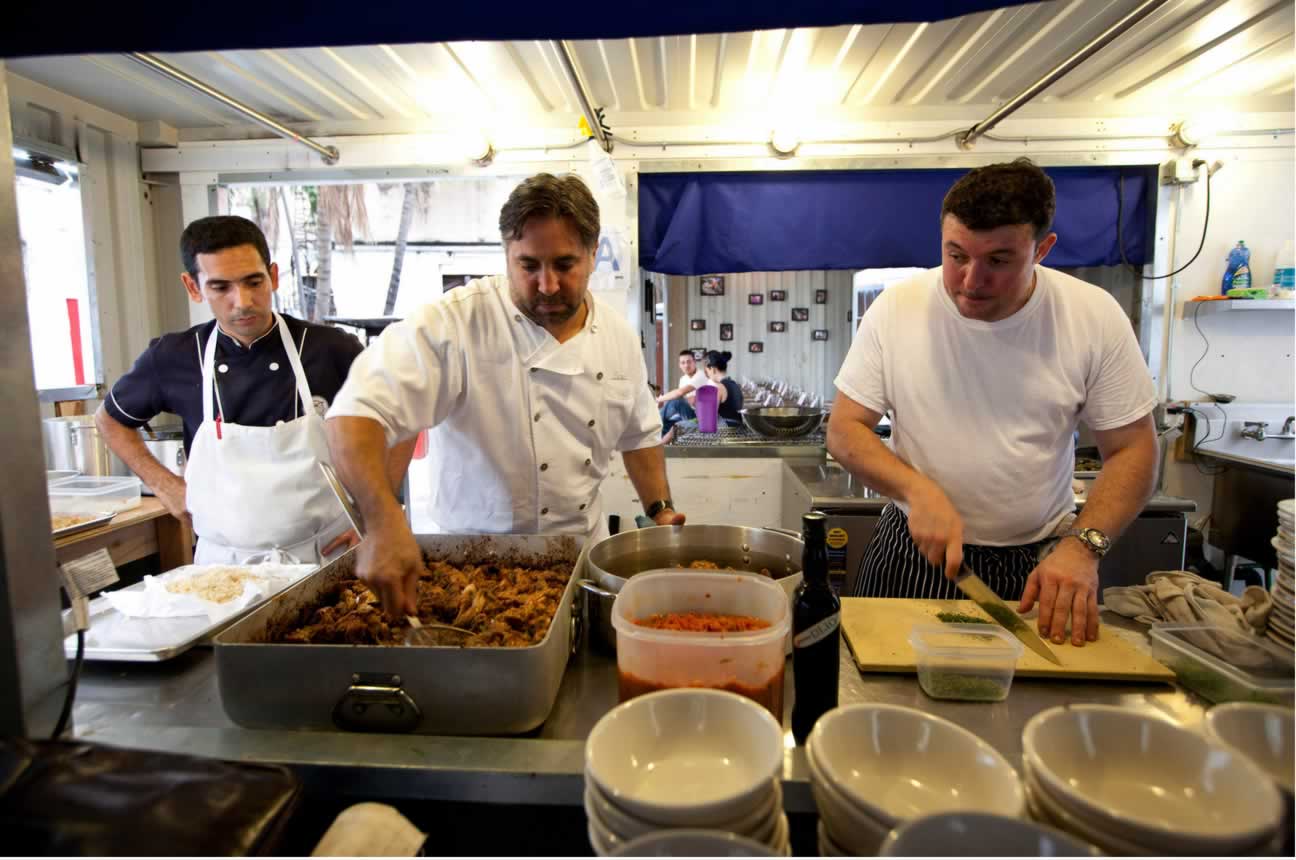HAVANA — It was at some point between the guava maki and the grilled sailfish with yuzu that Robert T. Coffland, an American art dealer who is normally reserved by nature, stood up and took off his shirt.
Mr. Coffland had complimented his fellow diner, Renny Arozarena, on his floral-print top. Without hesitation, Mr. Arozarena, a Cuban actor, unbuttoned it and handed it to Mr. Coffland. The quiet American reciprocated.
“It was a magical moment of letting go,” said Mr. Coffland, who has a gallery that deals in traditional textiles in Santa Fe, N.M. “I hadn’t even had that much to drink.”
Such bursts of camaraderie were what Craig Shillitto, an architect and a restaurant designer, had in mind when he devised Project Paladar, a 10-day collaboration that pairs 10 chefs, most based in New York, with 10 Cuban chefs in a restaurant built for the event from shipping containers.
Each night, one pair cooks for a mixed group of Cubans and foreigners, mostly American, who sit at long, rough wooden tables. The event, which ends on Sunday, forms part of the 11th Havana Biennial, which began last Friday and runs for a month.

Dayron Avila, left, a Cuban chef, with Mr. Canora and Mr. Valle. Credit Jose Goitia for The New York Times
“We wanted people to be able to meet Cubans and eat with them, rather than just see them on the other side of a service counter,” Mr. Shillitto said. “I think some of the relationships that have been created here are going to endure for a long time.”
The project is named for the small, privately owned restaurants, called paladars, that have sprouted up around the country, especially since the government opened more space for private enterprise 18 months ago. Financing and supplies for the event came from private donors, Mr. Shillitto said; the organizers charged some of the foreign guests $250 each to help cover expenses, like the chefs’ travel costs.
The organizers made a point of seating Cubans, who could eat free, alongside visiting diners and said they had invited Cubans of all stripes, from museum curators to the welders who helped build the restaurant.
In a country where many rely on food rations to help get them through the month and the diet produced by state-run farms is a monotony of tubers and beans, the Cuban diners were impressed, puzzled and delighted by turns.
“This is exquisite,” said José Pablo Carrasco, a guitar player who was tucking into the sailfish cooked by Anita Lo, owner of Annisa in New York. “We are not used to eating like this here.”
“I liked that round thing, too,” he added.
The sushi? “The Chinese thing.”
Japanese. “Whatever,” he said. “It was delicious.”
The buzz about the gastronomic encounter apparently was not lost on the political elite. On Wednesday, Ricardo Alarcón, president of the National Assembly, and Nilsa Castro Espín, one of President Raúl Castro’s daughters, turned up for a dinner of braised rabbit with white wine and rosemary and Nesquik panna cotta with cardamom, cinnamon, vanilla and pine nuts.
While forging bonds between diners might have been easy, producing world-class food in Havana was not. Chefs brought their own spices, oils, cheeses and knives from America, but some were stunned to discover how hard it is in Cuba to get ingredients and kitchen supplies they consider basic.
“It’s impossible,” declared Eduardo Valle, sous-chef at Del Posto in New York, who deemed the pork in the markets so unpleasant he steered other chefs away from it.
Early in his stay, he went on a mission to procure fresh fish, a surprisingly rare luxury here. He was driven to a house somewhere in Havana — no idea where, he said — and was told to wait in the car. “It was like we were buying weapons,” Mr. Valle said. “Unbelievable.”
On the other hand, the New Yorkers were thrilled by the organic farms scattered around the capital. On a trip to buy supplies on Monday, Marco Canora, owner of the East Village restaurant Hearth, and Mr. Valle chewed on moringa leaves at an organic farm in Alamar, on the outskirts of Havana, and admired a trough seething with Californian red worms, which are used to produce compost. Ms. Lo said it was a question of adapting to what was available.
“People in New York are used to all their tomatoes being the same size with little stickers on them,” Ms. Lo said. “There’s totally food here. There’s just a little more dirt on the roots.”
As the week wore on, the talk turned to future collaboration. Elizabeth Grady, who curated the installation, plans to compile a bilingual book with a recipe from each chef involved.
Enrique Núñez, owner of La Guarida, who spent much of the week buying produce and planning menus with Doug Rodríguez, an American chef of Cuban descent, said the two had planned for Mr. Núñez to go to Mr. Rodríguez’s restaurant Alma de Cuba, in Philadelphia, for a similar exchange.
“This has been one of the most incredible experiences I have ever had with a chef,” Mr. Núñez said of Mr. Rodríguez. “It’s like we’ve known each other for years.”
As for Mr. Coffland, he came away not only with a nice shirt but also with some optimism that the exchange would help bring Cubans and Americans closer.
“It’s the small actions that sometimes have a huge impact,” he said. “That’s what builds ties between countries.”
Source: www.nytimes.com



